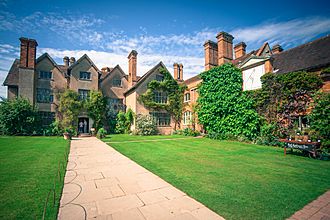Packwood House facts for kids
Quick facts for kids Packwood House |
|
|---|---|

The eastern front of the house
|
|
| General information | |
| Type | Country House |
| Location | near Lapworth, Warwickshire |
| Coordinates | 52°20′51″N 01°44′47″W / 52.34750°N 1.74639°W |
| Completed | Built 16th century |
| Renovated | Restored 20th century |
| Owner | National Trust |
Packwood House is a beautiful old house in Warwickshire, England. It's a special kind of house called a timber-framed Tudor manor. This means it was built with a strong wooden frame, a popular style during the Tudor period (around the 1500s).
The house is located near Lapworth, close to the border of Solihull. Since 1941, Packwood House has been looked after by the National Trust. This organization helps protect important historic places and natural spaces. Packwood House is also a Grade I listed building, which means it's considered very important historically and architecturally.
Inside, you can find many interesting things like old tapestries and beautiful furniture. But Packwood House is most famous for its amazing garden, filled with carefully shaped yew trees.
History of Packwood House
Packwood House started out quite small. It was built as a timber-framed farmhouse between 1556 and 1560 for a man named John Fetherston. His family owned the house for many years. The last member of the Fetherston family passed away in 1876.
In 1904, a businessman from Birmingham named Alfred Ash bought the house. Later, in 1925, his son, Graham Baron Ash, inherited it. Graham Baron Ash spent the next 20 years making the house look even more like a grand Tudor home. He collected many pieces of furniture from the 16th and 17th centuries. Some of these items came from a nearby historic house called Baddesley Clinton.
Graham Baron Ash also made some big changes to the farm buildings. He turned the large barn into a Tudor-style hall. This hall even had a special sprung floor for dancing! In 1931, he added a Long Gallery to connect this new hall to the main house.
In 1941, Graham Baron Ash gave Packwood House and its gardens to the National Trust. He did this to honor his parents. He continued to live in the house until 1947, when he moved to Wingfield Castle.
The Famous Gardens
The most well-known part of Packwood House is its amazing Yew Garden. This garden has over 100 yew trees! It was first designed in the mid-17th century by John Fetherston, who was a lawyer.
The yew trees are carefully clipped and shaped. They are meant to represent "The Sermon on the Mount" from the Bible. Twelve large yew trees are called the "Apostles". Four even bigger trees in the middle are known as the "Evangelists".
A path shaped like a tight spiral, lined with small box hedges, climbs up a small hill. This hill is called "The Mount". At the very top of "The Mount" is a single yew tree, known as "The Master". The many smaller yew trees around are called "The Multitude". These smaller trees were planted in the 1800s to replace an old fruit orchard.
You enter the Yew Garden by walking up some steps and through a beautiful wrought-iron gate. The garden path then leads you along an avenue of trees. This path goes up the spiral hill where you can find a wooden seat under a yew tree. From this spot, you get amazing views of the house and the entire Yew Garden.
Some of the yew trees at Packwood are very tall, over 50 feet (about 15 meters) high! The soil on the estate has a lot of clay. This can be bad for the trees when it rains a lot. Because of this, parts of the garden sometimes need to be closed for repairs. However, the house and gardens have been open to visitors all year round since 2013.
Gallery








